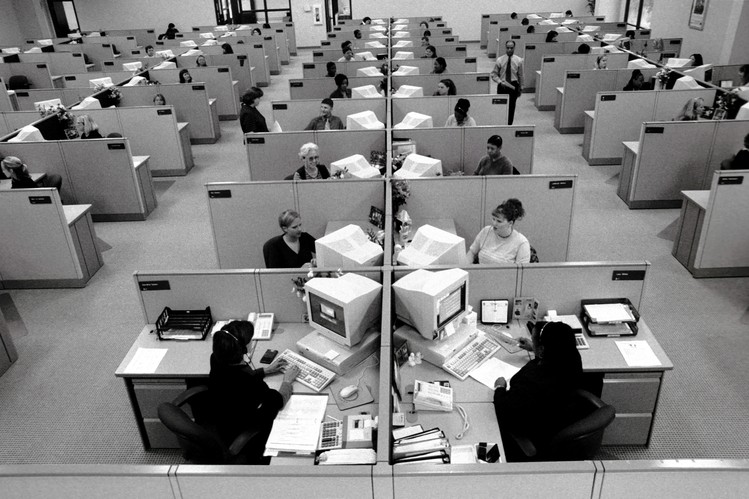Blimey, I’m really old.
I don’t want to give away my age ( let’s just say I am a bit older than you, don’t hold it against me ) but I remember when L-shaped workstations were introduced in the early 1990s, as desktop monitors were democratised for all, and not just for the bloke in the v-neck sweater and corduroys in the i.t department. It was well before Jonathan Ives designed his beautiful (and dare I say sexy?) monitor for Apple. Before then, monitors were big ugly blocks which haven’t aged well in the annuls of design. Even I have aged better. For Workplace Designers who had spent a lifetime planning offices with simple rectangular blocks with no need to think about power and data supply, it was a revolution which put them firmly in the driver’s seat as to how the new office should look.
Fast-forward to the early Noughties, and Workplace Designers were back in the driver’s seat, pushing the boundaries of efficient space-planning as flat-screen monitors became the norm and ‘Wave’ shaped desks were introduced. And then, before Designers could even catch their breath, the first bench desks were launched and adopted at breakneck speed, and Workplace Designers were back in the driver’s seat, planning vast open-plan spaces with rows of workers forced out of their private offices into the glaring sunlight of very public scrutiny from their colleagues! Brownie points to anyone who can remember the name of the first branded bench desk system…
Re-inventing the fast-spinning Wheel.
The past 12 months have put Workplace Designers firmly back in the driver’s seat. Things have been tossed up in the air, and have landed in a seemingly great big mess. Or have they?
In a recent survey of almost 400 companies by the UK’s CBI, more than 60 per cent of businesses invested in digital technologies and new management practices between March and July last year, 2020. Almost half said that they had introduced new products or services during the same period. And almost 40 per cent adopted new types of digital capabilities. No need to dwell on those numbers too much, trust me when I say that’s a lot of business change! It means companies – even conservative British ones – are reacting to change and opportunity at an incredible rate of knots. It’s a genuine work revolution, and it’s only just starting. And yet our workplaces are still very much static places. It’s true we talk a lot about agile and flexible spaces, but in reality we have designed offices and workspaces with furniture that is still anchored to specific areas. Everything is still in its perfect place, a kind of feng shui template for working. It’s time to re-invent the wheel, and it’s one of those key moments where Workplace Designers are well and truly back in the driver’s seat.
Look into the (murky) crystal ball of the workplace’s future…
We’ll all be working at home on the dining room table. No, in our sheds. No, in Coffee Shops. Two days a week. No, three days a week. On zoom meetings. No, in holographic work places. Superimposed in virtual conference rooms. No, as digital avatars. And when we do have to go into the workplace, we’ll all be hot-desking. No, desk-sharing. In suburban business parks. No, in big sheds on industrial parks. Deep breath……
Or none of the afore-mentioned, because things are changing so quickly, and none of us are really sure what will happen next.
There’s one thing for certain though. Contrary to the doomsayers, the future of the workplace is very much assured and alive, perhaps more so than ever. The workplace is going to be a hive of concentrated activity where people come and go as they need to or want to. The new workplace will be a dynamic, vibrant and energetic place to greet, meet, catch-up, be seen and be heard. A place to learn, innovate, create, and challenge.
And the new workplace will have to be the very opposite of static – it will have to be an environment that can transform itself from week-to-week, or even day-to-day. That’s why mobile office furniture solutions are the way forward, because it’s the only way to empower companies and their staff to make instant changes to the un-expected new ways they will need to work.
So, welcome everybody, I give you the mobile workplace of tomorrow where mobile furniture can be re-configured in an instant and adapt to the unknown. And the change will be made by Workplace Designers, once again in the driving seat as the agents of workplace change. And that has to be good news.
Ed Fidler, February 2021

